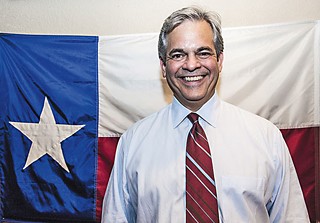Mayor: A Numbers Game
By Michael King, Fri., Dec. 5, 2014

Steve Adler vs. Mike Martinez
As run-off voting proceeds (through Dec. 12), the respective messages of the two remaining mayoral candidates are well established. Attorney Steve Adler is running as an anti-incumbent, for a "New Way Forward" – arguing that the city and the City Council have lost their way, and are "moving in the wrong direction" on the hot campaign topics: affordability, governance, traffic, equity. Incumbent Council Member Mike Martinez has pointed to his record on all these issues – workers' rights and wages, city budgeting, mass transit – and argued that actual Council experience matters, especially with an incoming Council that will have a large majority of newcomers.
During recent weeks, both campaigns have grown more aggressive: Martinez has charged Adler with representing wealthy interests, profiting from environmental destruction, and effectively campaigning as a de facto "Republican." Adler has denounced Martinez's charges as mudslinging, pointed to Martinez's support from an out-of-town "Super PAC" (South Forward, based in South Carolina), and repeated his drumbeat that on the questions that matter – traffic, affordability, education – Austin has moved backwards on Martinez's watch.
Judging from the public indicators, Adler's argument is gaining ground. He led 37-30% in the initial round (as the two candidates eliminated six other rivals), and the only public poll available – an Austin Monitor-commissioned, Nov. 12-13 phone poll by Public Policy Polling – reported Adler with a 56-35% lead among 846 likely voters. Adler said he was "pleased and excited" by the poll, but that it would not affect his campaigning – "the only poll that matters is the vote." Martinez said the poll "is what it is," but noted Adler's strong Republican support and his own relative lead among Democrats. "We've always been the underdogs," he said, "but we'll take that lead among Democrats in Travis County any day."
Certain aspects of Round 1 and the Monitor poll could give either candidate comfort. Martinez noted that Republican voters drawn out by the high-profile statewide races would have less motivation to return on Dec. 16, but he believes he'll run stronger among voters he considers his base, hardcore Democrats. It's true that Adler's poll numbers were particularly strong among Republican voters – 84% said they were likely to vote for him in the run-off – but he polled only three points behind Martinez among Democrats (48-45%). And Adler is quick to note that the poll also showed significant support among African-Americans likely to vote in the run-off (43-24%).
That result raises another issue visible in the Nov. 4 outcome; the voting patterns overall reflected a fairly strong east-west breakdown, with Adler's strongest precincts on the west side of the city, and Martinez's strongest boxes on the Eastside – with the exception of the central east and northeast boxes that went to Mayor Pro Tem Sheryl Cole. Martinez said the visibly split map generated concern among his potential supporters, and that in response to it, additional volunteers arrived at his campaign. "That's not my Austin," Martinez says they told him.
Adler dismissed the split map as misleading and insisted that he has strong support across the city; he quickly followed Nov. 4 with a series of press conferences featuring Hispanic, African-American, and Asian-American supporters. "I don't think there's an east-west split," he told the Chronicle, and argued that Martinez's Eastside pluralities were relatively weak.
And that dispute raises another aspect of the race that likely works in Adler's favor: Martinez's strongest precincts are in relatively low-turnout districts. District 10 alone, for example, had more Nov. 4 Council voters (27,856) than Districts 2, 3, and 4 combined (27,105). Martinez's task – to overcome Adler's lead – is not impossible, but it's certainly daunting.
Got something to say on the subject? Send a letter to the editor.










